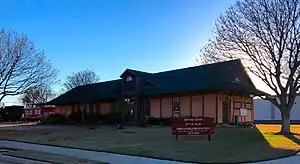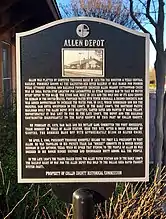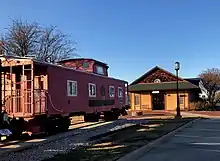Allen Depot (Allen, Texas)
Allen Depot was established in 1876 in the central ward of Allen, Texas. The train depot served as a water stop for the Galveston and Red River Railway chartered by Ebenezer Allen in 1848.[1] By 1856, the Southeast Texas to Red River railroad would transition to the Houston and Texas Central Railway.[2]
Allen Depot | |
|---|---|
 | |
| General information | |
| Other names | Allen Heritage Center |
| Location | 100 East Main Street Allen, Texas United States |
| Coordinates | 33°06′09.42″N 96°40′10.59″W |
| Owned by | Houston and Texas Central Railway |
| Tracks | 1 |
| Construction | |
| Structure type | at-grade |
| Architectural style | American Foursquare |
| Other information | |
| Website | Allen Depot - AllenHeritage.org |
| History | |
| Opened | 1 January 1876 |
| Closed | 1 January 1959 |
| Location | |
By 1872, the Allen township began to acknowledge the progression of the track rail with the completion of the railway to Red River City, Texas by 1873.[3]
By the 1950s, the Allen Depot began to observe a significant regression in steam locomotive railway traffic due to the progression of the American automobile industry in the 1950s and the United States interstate highway system.
Allen Water Station
In 1874, the Houston and Texas Central Railway purchased a sector of land from Collin County resident J.W. Franklin to construct a water station to meet the water source demand as required by steam locomotives.[4]
The Allen Water Station was recognized as a Texas historic site receiving a historical marker in 2015.[5]
History of Allen Depot
Sam Bass and Black Hill Bandits in Texas
The Old West outlaw Sam Bass and the Black Hill Bandits organized the first successful train robbery in the State of Texas within the vicinity of the Allen Depot on February 22, 1878.[6][7][8][9]
United States President Theodore Roosevelt Train Caravan of 1905
.jpg.webp)
On April 5, 1905, President Theodore Roosevelt visited the Allen Train Depot while enroute to San Antonio, Texas for a Rough Riders reunion at the Menger Hotel.[10][11][12]
The 26th President of the United States was cordially received by a vast jubilation who traveled one hundred miles or more by buckboard, buggy, and horseback across North Texas as President Roosevelt delivered speeches concerning his domestic Square Deal program.
In remembrance of President Theodore Roosevelt's 1905 appearances in Denison, Texas and Sherman, Texas, the Texas Historical Commission established a State of Texas historical marker in 1971 in Grayson County, Texas serving as a neighbor to the north of Collin County, Texas.[13][14][15]
Epidemic of 1860s and Texas Railways
In 1860s, the southern Texas counties confronted the predatorial Aedes aegypti or an arthropod ultimately arriving through trade ports along the Texas Gulf Coast.[16][17] The tropical infectious mosquito served as an asymptomatic carrier of an arbovirus progressively inflicting the symptoms of yellow fever on the South Texas civil parishes.[18][19][20][21]
During the Gilded Age, the Texas railways established mounted regiments of health officers drawn on horseback to conduct quarantines of steam locomotives transporting rail travelers.[22] The passenger railroad cars or Pullman coaches could potentially be hazardous providing conditions for a pathogen transmission of the mosquito-borne disease scientifically known as a flavivirus.[23]
Orphan Train Movement of 1854-1929
By the early 1850s, the U.S. states began to acknowledge over-crowding in the Eastern Seaboard cities. The Eastern United States instituted the guardianship of an Orphan Train movement for youth dependants determined as abandoned, homeless, orphaned, and street children in an American census-designated place.[24] The American youth were missioned by the ideology of manifest destiny to an agrarian society in the American frontier.[25]
.jpg.webp)
The social welfare initiative sustained seventy-five years enduring from 1854 to 1929 in the United States. On May 31, 1929, an orphan train departed New York City for a final steam locomotive journey with a terminative destination at Sulphur Springs, Texas.[26]
| Distinguished Orphanage Guilds in State of Texas |
| • Edna Gladney |
| • Evandberg Orphanage |
| • Galveston Orphans Home[27][28] |
| • Masonic Home and School of Texas[29] |
| • St. Mary's Orphan Asylum[30] |
Bibliography Pictorial
 LS&I steam locomotive at the Allen Heritage Center
LS&I steam locomotive at the Allen Heritage Center Allen Depot established in 1876 forming the Houston and Texas Central Railway
Allen Depot established in 1876 forming the Houston and Texas Central Railway Village Express caboose at the Allen Heritage Center
Village Express caboose at the Allen Heritage Center
See also
References
- Young, Nancy. "Galveston and Red River Railroad". Handbook of Texas Online. Texas State Historical Association.
- Werner, George C. "Houston and Texas Central Railway". Handbook of Texas Online. Texas State Historical Association.
- Hart, Brian. "Red River, TX (Grayson County)". Handbook of Texas Online. Texas State Historical Association.
- "Allen Railroad Dam - Allen Water Station". Collin County, Texas, History. Collin County History.
- "Allen Water Station - Collin County ~ Marker Number: 18112". Texas Historic Sites Atlas. Texas Historical Commission.
- Gard, Wayne. "Bass, Sam (1851–1878)". Handbook of Texas Online. Texas State Historical Association.
- Jones, Caroline. "Did You Know in Texas History: Texas Outlaw Sam Bass". Out of the Stacks. Texas State Library and Archives Commission.
- Gillett, James B. (August 12, 1902). "The Story of Sam Bass". The Historic Round Rock Collection. City of Round Rock.
- "The Sam Bass Gang - First Train Robbery in Texas". Internet Archive. U.S. National Archives and Records Administration. 17 November 2007.
- "Pres. Roosevelt greeting "the boys" who fought in Cuba--"Rough Rider" reunion at San Antonio, Texas". Library of Congress Prints and Photographs Division. United States Library of Congress. April 1905. LCCN 89712981.
- "President Roosevelt with officers of the army and "Rough Riders" - reunion at San Antonio, Texas". Library of Congress Prints and Photographs Division. United States Library of Congress. April 1905. LCCN 2002705702.
- "President Roosevelt and Rough Riders at San Antonio, 1905". Library of Congress Prints and Photographs Division. United States Library of Congress. April 1905. LCCN 2009633769.
- "Enthusiastic Welcome to the Nation's Chief - All of Denison, Texas Greets President Roosevelt". Photo, Print, Drawing. United States Library of Congress. LCCN 2010649461.
- "Splendid Greeting to Pres. Roosevelt, by the Great Crowds at Denison, Texas". Photo, Print, Drawing. United States Library of Congress. LCCN 2013649472.
- "President T. Roosevelt's Visit to Grayson County - Sherman, Texas ~ Marker Number: 11527". Texas Historic Sites Atlas. Texas Historical Commission.
- "Galveston Quarantine Stations - Galveston County ~ Marker Number: 7474". Texas Historic Sites Atlas. Texas Historical Commission. 1993.
- Doleshal, Ph.D., Zachary. "The Yellow Fever Epidemic of 1867". East Texas History. Sam Houston State University.
- "The Yellow Fever Epidemic of 1862 - Matagorda County ~ Marker Number: 18121". Texas Historic Sites Atlas. Texas Historical Commission. 2015.
- "The Huntsville Yellow Fever Epidemic of 1867 - Walker County ~ Marker Number: 18491". Texas Historic Sites Atlas. Texas Historical Commission. 2016.
- "Yellow Fever Epidemic of 1867 - Fayette County ~ Marker Number: 18523". Texas Historic Sites Atlas. Texas Historical Commission. 2016.
- "Livingston Lindsay to Texas Governor Elisha M. Pease, October 9, 1867" [Letter on the Devastating Yellow Fever Epidemic in La Grange]. Portraits of Texas Governors ~ War, Ruin, and Reconstruction Part II, 1866-1876. Texas State Library and Archives Commission.
- "Dallas Texas Yellow Fever Health Officers Stop Train - 1873" [Artist F. T. Ryan Engraving Print]. Worthopedia. WorthPoint Corporation.
- Clark, Penny. "Yellow Fever". Handbook of Texas Online. Texas State Historical Association.
- "Orphan Train History". National Orphan Train Museum and Research Center. Concordia, Kansas: National Orphan Train Complex.
- Johnson, Mary Ellen. "Orphan Train Heritage Society of America, Inc. (OTHSA)". Post-Reconstruction through the Gilded Age (1875 - 1900). Little Rock, Arkansas: Encyclopedia of Arkansas.
- "The Orphan Train and the Children Who Rode It". Massachusetts. New England Historical Society. 6 March 2015.
- "Galveston Orphans Home ~ Marker Number: 18286". Texas Historic Sites Atlas. Texas Historical Commission. 2015.
- "Galveston Orphans Home ~ NRHP: 79002943". Texas Historic Sites Atlas. Texas Historical Commission. March 21, 1979.
- "Masonic Widows and Orphans Home Historic District ~ NRHP: 91002022". Texas Historic Sites Atlas. Texas Historical Commission. January 28, 1992.
- "Original Site of St. Mary's Orphan Asylum ~ Marker Number: 7175". Texas Historic Sites Atlas. Texas Historical Commission. 1994.
Historical Video Archive
| ☆ Orphan Trains Rescued New York's Homeless Children on YouTube |
| ☆ Allen City TV (23 September 2015). "Riders on the Orphan Train". Internet Archive. U.S. National Archives and Records Administration. |
| ☆ Allen City TV (17 November 2007). "The Sam Bass Gang - First Train Robbery in Texas". Internet Archive. U.S. National Archives and Records Administration. |
External links
 Media related to Allen Depot (Allen, Texas) at Wikimedia Commons
Media related to Allen Depot (Allen, Texas) at Wikimedia Commons- "Stone Dam at Allen Station" [Allen in Collin County, Texas - The American South (West South Central)]. HMDB.org. The Historical Marker Database.